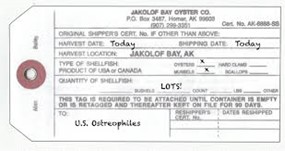Seafood:
Any seafood sold through the food hub needs to be from a DEC permitted seafood processor.
You can find a list of all permitted seafood processors at: https://dec.alaska.gov/eh/fss/active-permits/
Shellfish:
Shellfish is a nutritious local Alaskan product, and oysters especially are popular on some food hubs. Shellfish has been associated with illness if not harvested from waters that are regulated. Regulated shellfish farms conduct routine water monitoring and testing their shellfish product to ensure that the product is safe to consume.
The DEC provides resources on harvest, processing, transportation, and more, including templates for required records on their website https://dec.alaska.gov/eh/fss/shellfish/resources/
The following information is an example of some shellfish requirements. Food hubs should contact DEC representatives and check the website for more detail.
Raw shucked shellfish must be obtained in containers which bear a legible label that identifies the name, address, and certification number of the shucker-packer. The label must also include the “sell by” date for packages of less than one-half gallon or the date shucked for packages larger than one-half gallon.
Each container of shellstock must have the certified shellfish dealer’s tag with required harvest information. The tags must have the following information in this order:
- Dealer name, address, and certification number
- Original shipper’s certification number
- Date of harvest
- Harvest location, including water body and specific site designation
- Type of quantity of shellfish
- The statement in bold capitalized letters: This tag is required to be attached until container is empty, retagged and thereafter kept on file for 90 days”

Shellstock (unshucked oysters, for example) may be packaged in self-service containers if each self-service container is plainly marked with the type and quantity of shellfish, harvest location, date of harvest, and dealer certification number.
Proper storage is critical to control the growth of harmful bacteria in oysters. Containers of shucked oysters should be stored at 32 – 38 °F, ideally packed in ice. Temperatures that low may kill a live oyster, so unshucked oysters should be stored at 40 – 45°F. In addition they need to be stored upright, and without being submerged in water.
The following consumer advisory should be on each shellfish tag: Consuming raw or undercooked meats, poultry, seafood, shellfish or eggs may increase your risk of foodborne illness, especially if you have certain medical conditions.
Sometimes the food hub must keep copies of the shellfish tag and records of temperature control. This varies depending on location and food hub operation, once again, check in with your DEC agents to see what is appropriate to do for your food hub.